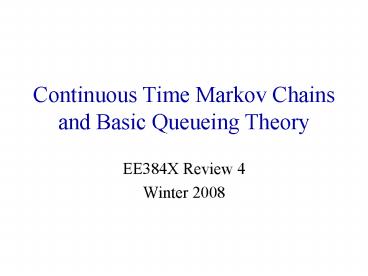Continuous Time Markov Chains and Basic Queueing Theory - PowerPoint PPT Presentation
1 / 13
Title:
Continuous Time Markov Chains and Basic Queueing Theory
Description:
These timers are independent of each other. Recall that Exponential distribution is memoryless. When the first timer expires, the MC makes the corresponding transition ... – PowerPoint PPT presentation
Number of Views:45
Avg rating:3.0/5.0
Title: Continuous Time Markov Chains and Basic Queueing Theory
1
Continuous Time Markov Chainsand Basic Queueing
Theory
- EE384X Review 4
- Winter 2008
2
Review DTMC
- pij is the transition probability from i to j
over one time slot - The time spent in a state is geometrically
distributed - Result of the Markov (memoryless) property
- When there is a jump from state i, it goes to
state j with probability
3
Continuous Time Version
- qij is the transition rate from state i to state
j
4
CTMC
- Upon entering state i, a random timer
TijExp(qij) is started for each potential
transition i!j - These timers are independent of each other
- Recall that Exponential distribution is
memoryless - When the first timer expires, the MC makes the
corresponding transition - Let Ti be the time spent in state i, and qiåj¹i
qij, then Ti Exp(qi) - When there is a transition, the probability of
jumping to state j is qij /qi
5
Definitions
- X(t)t0 is a continuous time Markov chain
ifPX(st)j X(u) us PX(st)j X(s) - Similar to Discrete Time MCs, Continuous Time MCs
have stationary distribution p - Exists when Markov chain is positive recurrent
and irreducible
6
Stationary Distribution
- Balance equations
- Transition rates in and out of state i are equal
- Define matrix transition rate Q (qij) with qii
-qi , then p Q 0, where p is a row vector - Together with åi p(i) 1, can solve for p
7
Queueing Theory Notation
- A/S/s/k
- A is the arrival process, e.g., Geometric,
Poisson, Deterministic - S is the service distribution, e.g., Geometric,
Exponential, Deterministic - s is the number of servers, e.g., 1, N, 1
- k is the buffer size (if k is absent, then k 1)
- E.g., Geom/M/1, M/M/1, M/D/1, M/M/1
8
M/M/1 Queue
- Arrivals are Poisson with rate l
- Inter-arrival times are exp(l)
- Services are exponential with rate m
- These are also transition rates for the Markov
chain - This looks very similar to Geom/Geom/1 queue, but
different
9
Solving M/M/1 Queue
- We have pi l pi1 m
- Let r l/m, then pi pi-1 r p0 ri
- If r lt 1, the stationary distribution exists
pi (1 - r) ri - Average Queue size
10
M/M/1 Queue
- NQ is the queue size, excluding the one in
service
11
M/M/1 Queue
- Customer arrival process is Poisson(l)
- All customers are served in parallel exp(m)
- Departure rate proportional to of customers
12
Solving M/M/1 Queue
- We have pi-1 l pi i m
- Let r l/m, then
- Thus
13
M/M/1 Queue
- The queue size distribution of the M/M/1 queue is
Poisson(r) - Therefore the average queue size is E(Q)r
- Whats the condition for the queue to be
recurrent?































